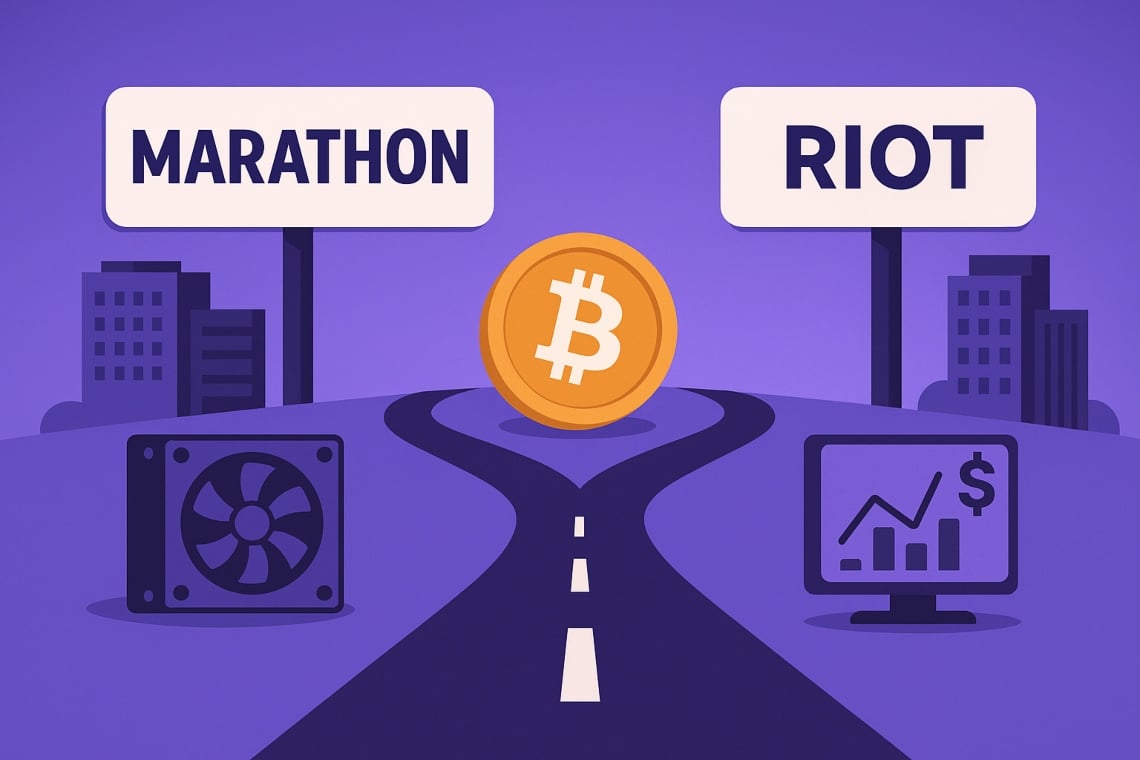strategies for financing Bitcoin mining

In the U.S. landscape of Bitcoin mining, two of the major players, Marathon Digital Holdings (MARA) and Riot Platforms, have chosen opposite strategies to finance their activities in the second quarter of the year.
This divergence not only reflects different views on corporate treasury management but also provides an interesting insight into the dynamics that drive the institutional sector of bitcoin mining.
Mara: bet everything on equity and keep bitcoin as a mining strategy
Marathon strengthened its position in the second quarter by raising 204 million dollars through the sale of shares, more than double the 80 million obtained in the previous quarter.
This choice is consistent with its strategy of keeping all mined bitcoins in treasury, without selling them on the market. In other words, Marathon adopts a “100% HODL” policy, avoiding selling bitcoins to finance daily operations or business growth.
During the second quarter, Marathon did not resort to its interest-bearing credit line, after having already withdrawn 150 million dollars in the first quarter.
This prudence in borrowing underscores the company’s desire to limit debt exposure and to rely primarily on the equity markets to raise capital.
At the end of the second quarter, Marathon took a significant step by issuing 1 billion dollars in zero-coupon convertible bonds maturing in 2032.
This is a financial instrument that allows for raising capital without paying periodic interest, offering investors the possibility to convert the bonds into company shares.
Unlike Marathon, Riot has slowed its capital raising through shares, going from 70 million dollars in the first quarter to 51 million in the second.
The real difference, however, lies in the management of the produced bitcoin: Riot sold 96.5% of its quarterly production, that is 1,377 bitcoin out of 1,427 mined, to finance operating expenses.
In the second quarter, Riot increased its use of debt, bringing credit-based financing to 251 million dollars, starting from zero in the previous quarter.
An important step was the agreement with Coinbase for a 100 million dollar line of credit in April, later increased to 200 million and fully utilized.
Furthermore, in August 2024, Riot launched an “at-the-market” offering program to raise up to 750 million dollars through the sale of shares. As of June 30, 2025, approximately 238.3 million dollars were still available to be raised through this channel.
Treasury Philosophies Compared
The strategy of Marathon is based on the belief that bitcoin represents an asset to accumulate and hold, rather than a resource to liquidate for operational needs.
For this reason, the company prefers to turn to financial markets to raise capital, either through the issuance of shares or through convertible debt instruments, leaving the bitcoin in the portfolio untouched.
Riot, on the other hand, has adopted a more flexible approach, combining the sale of bitcoin with the use of credit lines and, to a lesser extent, new stock issuances.
This strategy allows for financing growth and operating expenses without necessarily having to dilute the equity stake or accumulate excessive debt.
The choices of Marathon and Riot highlight how in the bitcoin mining sector there is no single strategy for financing growth.
On one hand, Marathon’s HODL policy aims to maximize the long-term value of the bitcoins held, trusting in their future revaluation.
On the other hand, Riot favors immediate liquidity and diversification of funding sources, reducing dependence on bitcoin price fluctuations.
These differences reflect not only different views on the nature of bitcoin as an asset, but also different assessments of the risk and opportunities offered by traditional financial markets.
Conclusions: two models for the future of mining
The second quarter highlighted how Marathon and Riot represent two opposing but both valid models for facing the challenges of bitcoin mining in a context of increasing competition and market volatility.
The choice between holding bitcoin as a strategic reserve or using them to finance immediate growth remains one of the central issues for the major operators in the sector.
The future will tell which of the two strategies will prove more effective, but one thing is certain: the ability to adapt and innovate in financial management will be increasingly crucial for success in the world of bitcoin mining.

